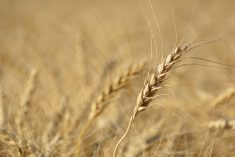Ukraine is poised to harvest a smaller and poorer quality wheat crop than last year, according to a Ukrainian agriculture consultancy firm.
UkrAgroConsult is forecasting 25.9 million tonnes of production, down from 29.1 million tonnes last year.
Grain harvested from the far south will be shriveled but the protein content is expected to be higher than normal, Maryna Marynych, the firm’s grain market analyst, said in a recent webinar.
Crop quality in the northern part of the country will be poor and there is the possibility that will be the case in the west and southwest regions as well.
Read Also

Chinese offer complicates canola marketing
Recently the Chinese ambassador indicated that there would be a potential deal between Canada and China regarding the current tariff war.
“Intense rain has contributed towards the development of disease, which will negatively affect the quality of the wheat,” she said.
Last year, the country harvested a good quality crop with 56 percent of its exports being milling quality. This year the proportion will be closer to 45 to 50 percent.
Marynych is forecasting 16.9 million tonnes of exports, which is lower than the United States Department of Agriculture’s estimate of 17.5 million tonnes and well below the 20.5 million tonnes shipped out in 2019-20.
She is forecasting strong competition from Russia’s 78 million tonne crop. Russia will export 36 to 38 million tonnes of the crop, up from 33.5 million tonnes in 2019-20.
Prices in Ukraine are expected to be down due to the Russian competition but she noted that drought in Kazakhstan is expected to intensify in August and September and there are also reports of locust damage in that country.
Sergey Feofilov, director general of UkrAgroConsult, said there will be “considerable modification” of Ukraine’s wheat markets this year.
Shipments to Turkey, which has been one of the country’s top customers, are expected to fall 25 to 30 percent due to improved crop conditions there.
The biggest change in wheat markets will come from the return of Australia. The USDA is forecasting 17 million tonnes of exports, up from 9.2 million tonnes last year.
Australia will compete with Ukrainian wheat in Asia where Ukraine had made big inroads in markets such as Indonesia and Bangladesh.
Feofilov anticipates brisk sales out of the Black Sea region in the July-through-December period as exporters fear the possible return of export restrictions.
There is also likely to be strong demand in that period due to ongoing food security concerns prompted by COVID-19.
“All buyers will try to increase their wheat stocks immediately after wheat harvesting,” he said.
Ukrainian canola production will be down despite record seeded area due to 16 percent winterkill. The firm is forecasting a 2.9 to three million tonne harvest.
Canola prices have been on the rise in Ukraine and the consultancy does not expect a decline in prices anytime soon due to production problems in the European Union, where Ukraine is facing stiff competition from Canadian exports.
Barley production is forecast at 7.9 million tonnes, which is well below the USDA’s estimate of 9.4 million tonnes. Exports are pegged at 4.25 million tonnes, which is again below the USDA’s forecast of five million tonnes.
Feofilov said there has been a trend of declining Ukrainian barley sales to Saudi Arabia and increasing shipments to China.
Ukraine’s shipments to Saudi Arabia fell 43 percent last year, largely replaced by exports from the European Union.
He expected decreased export competition from the European Union in 2020-21 but stiffer competition from Russia due to unusually high carryover stocks in that country.
Australian barley will hit the market in October/November. That country will be searching for new markets due to a trade spat with China.















